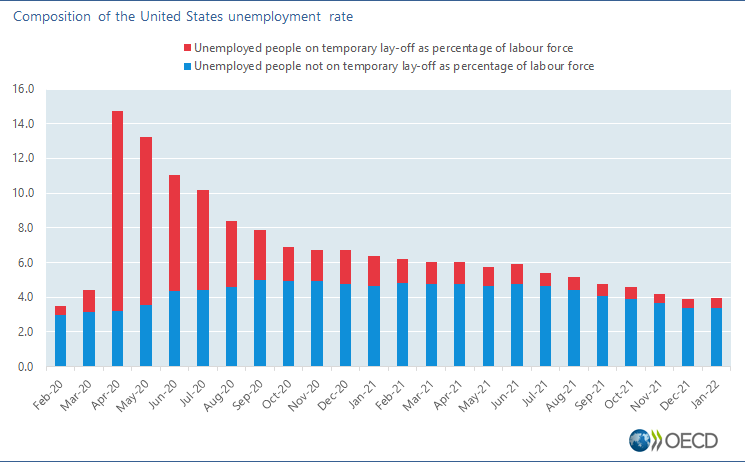Unemployment rate in the OECD area drops further to 5.4% in December 2021
Download the entire news release (graphs and tables included, PDF)
8 Feb 2022 – The monthly unemployment rate in the OECD area fell for the eighth consecutive month to 5.4% in December 2021, down from 5.5% in November, bringing it to just 0.1 percentage point above the pre-pandemic rate recorded in February 2020 (see Figure 1). The number of unemployed workers across the OECD area also continued to fall (by 0.7 million) reaching 36.1 million, still 0.5 million above the pre-pandemic level. In December (or the latest period available), the unemployment rate was below the pre-pandemic level in Australia, Chile, France, Iceland, Italy, Lithuania, Luxembourg, the Netherlands, New Zealand, Portugal, Spain and Turkey1 (see Figure 3).
The unemployment rate in the OECD area declined among both women (to 5.6%, from 5.7% in November) and men (to 5.2%, from 5.3%). It fell at a faster pace among younger people aged 15 to 24 (to 11.5%, from 11.8% in November), than prime age and older workers aged 25 and above (to 4.6%, from 4.7%).
In the euro area, the unemployment rate also declined for the eighth month in a row in December (to 7.0%, from 7.1% in November), falling by 0.3 percentage point or more in Austria (to 4.9%, from 5.2%), Greece (to 12.7%, from 13.3%), Lithuania (to 5.6%, from 6.0%), Portugal (to 5.9%, from 6.3%) and Spain (to 13.0%, from 13.4%), but increasing by 0.4 percentage point in Finland (to 7.2%, from 6.8%). During the same month, the unemployment rate among the younger people in the euro area fell by 0.5 percentage point (to 14.9%, from 15.4%).
In December, the unemployment rate fell by 0.3 percentage point or more in Australia (to 4.2%, from 4.6% in November), Colombia (to 12.6%, from 13.0%), and the United States (to 3.9%, from 4.2%). It decreased by 0.1 percentage point in Canada (to 6.0%) and Japan (to 2.7%), but increased by 0.1 percentage point in Mexico (to 3.9%) and by 0.7 percentage point in Korea (to 3.8%). More recent data show that the unemployment rate rose by 0.5 percentage point in Canada (to 6.5%) in January 2022 and by 0.1 percentage point in the United States (to 4.0%) (see Figure 2).
It should be noted that the unemployment rate conceals the extent of the unmet labour demand as some non-employed people may be “out of the labour force”, and hence not captured by the unemployment rate, either because they are not actively looking for a job or are not available to work.
Breaks between December 2020 and January 2021 for several EU Member States resulting from changes in the EU Labour Force Survey. This break can affect, to some extent, aggregates for the euro area and OECD Total.
The fall in the OECD area unemployment rate when compared with the April 2020 peak should be interpreted with caution, as it largely reflects the return of temporary laid-off workers in the United States and Canada, where they are recorded as unemployed, unlike in most other countries, including European member states, where they are recorded as employed
Link to underlying data – Source: Labour Force Statistics

Source: OECD calculations based on US Current Population Survey
For Canada and the United States, the statistical treatment of people on temporary layoff is different from other countries, where these people are typically recorded as employed. See the note on the divergence in employment and unemployment statistics during the Covid-19 crisis in the end of this news release
1. European countries which experienced a methodological break between December 2020 and January 2021 in their unemployment series were excluded from this list (see methodological changes in the EU Labour Force Survey).







